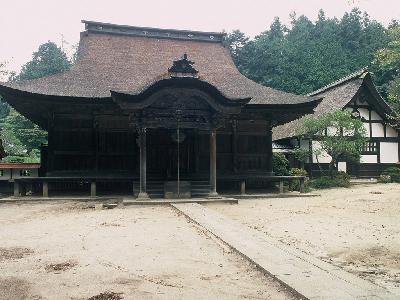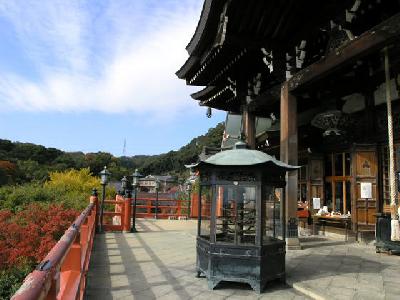|
Tenonji Temple in Okazaki City, Aichi Prefecture, is a temple of the Myoshinji school of the Rinzai sect. The temple was founded by the Zen monk Kensho Goshin in 1362 by the order of the 3rd Shogun of the Muromachi Shogunate, Ashikaga Yoshimitsu, on behalf of his grandfather, Ashikaga Takauji, who had made a vow before he died that he would construction a temple at this place in appreciation for the fulfillment of his prayer for victory.
The stately main gate built in the Yakuimon style looks like a castle gate. The main hall is a Chinese-styled building with the large camber on the outer side of the roof. It is nationally designated as an Important Cultural Property. In front of the main hall is a Hojo-ike Pond (set living things free pond), which is typical to a Zen temple.
In the precinct stands a huge cedar tree named “Ieyasu-ko Mikaeri-no-sugi (the cedar tree that Ieyasu looked back at).” According to a legend, when Tokugawa Ieyasu visited this temple to pray for his victory, he heard someone calling his name. He turned around to see who it was, when an assassin was just going to launch an arrow at him from behind a huge cedar tree. It was Enmei Jizo Bosatsu (Life Lengthening Jizo) that called him and Ieyasu narrowly escaped from being shot. When he left the temple for a battle field, Ieyasu looked back at the cedar tree over and over again to show his gratitude to Jizo Bosatsu.
The stately main gate built in the Yakuimon style looks like a castle gate. The main hall is a Chinese-styled building with the large camber on the outer side of the roof. It is nationally designated as an Important Cultural Property. In front of the main hall is a Hojo-ike Pond (set living things free pond), which is typical to a Zen temple.
In the precinct stands a huge cedar tree named “Ieyasu-ko Mikaeri-no-sugi (the cedar tree that Ieyasu looked back at).” According to a legend, when Tokugawa Ieyasu visited this temple to pray for his victory, he heard someone calling his name. He turned around to see who it was, when an assassin was just going to launch an arrow at him from behind a huge cedar tree. It was Enmei Jizo Bosatsu (Life Lengthening Jizo) that called him and Ieyasu narrowly escaped from being shot. When he left the temple for a battle field, Ieyasu looked back at the cedar tree over and over again to show his gratitude to Jizo Bosatsu.
| [+ADDRESS] | 
|




















